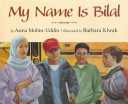by Seemi Aziz, Tucson, Arizona
 After looking at the 11 picturebooks in this collection I came away with the realization that these books merely covered a few regions that Muslims occupy as well as a handful of situations. These limited portrayals provide only a window of restricted representations. For instance, the necessary voices of children living in the Western countries are represented in books that come across as didactic and may turn off the audience in western countries even if the content is culturally relevant. Amira’s Totally Chocolate World and Mobin-Uddin’s My Name is Bilal are two such examples. The only other example of Muslims growing up in the west is The Champ: The Story of Muhammad Ali which is more an example of historical fiction and not an actual representation of the concerns being felt by Muslim youth residing in the western nations presently. Nye’s Sitti’s Secrets draws a great example of living in Palestine as compared to the U. S. and does provide a good sample of the issues that are debatable in the Palestinian/Israeli struggle and the option a child emotionally simplifies into merely voting for peace when it comes to individuals rather than that of the overarching politics of the region and its leaders.
After looking at the 11 picturebooks in this collection I came away with the realization that these books merely covered a few regions that Muslims occupy as well as a handful of situations. These limited portrayals provide only a window of restricted representations. For instance, the necessary voices of children living in the Western countries are represented in books that come across as didactic and may turn off the audience in western countries even if the content is culturally relevant. Amira’s Totally Chocolate World and Mobin-Uddin’s My Name is Bilal are two such examples. The only other example of Muslims growing up in the west is The Champ: The Story of Muhammad Ali which is more an example of historical fiction and not an actual representation of the concerns being felt by Muslim youth residing in the western nations presently. Nye’s Sitti’s Secrets draws a great example of living in Palestine as compared to the U. S. and does provide a good sample of the issues that are debatable in the Palestinian/Israeli struggle and the option a child emotionally simplifies into merely voting for peace when it comes to individuals rather than that of the overarching politics of the region and its leaders.
Baker’s Mirror is an excellent book that leaves a lot to the imagination of the reader, as it is a wordless picturebook. There are a ton of issues that can be raised and discussed within the visual text. Of course the issue remains that there is a comparative drawn between rural Morocco and urban Australia and it is not a fair one.
The other examples in this set are those that those that highlight struggles and reinforce some strong stereotypes. For instance those of poverty, refugee, war, that I will address in greater detail in the next blog…
Please visit wowlit.org to browse or search our growing database of books, to read one of our two on-line journals, or to learn more about our mission.
- Themes: Seemi Aziz
- Descriptors: Books & Resources, WOW Currents
